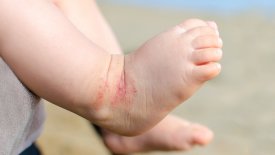Baby eczema: understanding the condition
In this article:
- How common is Eczema?
- What causes eczema?
- What does it look like?
- How do I treat the Eczema?
- Is there anything else I can do?
- Main Points

Eczema is essentially dry and itchy skin and is synonymous with the word dermatitis1. When describing the cause of eczema, or who it affects, you will often see words added before eczema, such as atopic eczema (associated with an irritant or allergy) or infant and baby eczema (describing the affected age group). Overall, there are many variations of eczema, including contact dermatitis or seborrhoeic dermatitis, but we will focus on atopic and infant and baby eczema.
How common is Eczema?
Eczema is an extremely common condition that affects 1 in 5 children, most often occurring before the age of 6 months, and 60% of those children who are going to develop it will do so by the age of 1.
What causes eczema?
Eczema is a complex condition, and while we don’t know exactly what causes it 2, we do know that it is not contagious but that it can be associated with allergic conditions (asthma and hay fever) and irritating chemicals (soaps and perfumes), can run in families, and is rarely associated with food allergies, such as cow’s milk protein.1 Fortunately, for the majority of children, it clears up by their teens, and in cases that it doesn’t, while we can’t cure it, the aim is to control it so it is not seen or felt.
What does it look like?
Eczema will cause your baby to develop dry, red, itchy patches. These often occur on the face, neck and any area where skin folds rub together, such as the stomach, the inner elbows and inner knees.3 This irritation and itching can cause your baby distress, affecting their sleep, as they will often find the need to scratch the patches of eczema – a ‘flare up’. The skin is your body’s protective barrier, and the itching can lead to infection, causing thick, scaly areas if left untreated.
How do I treat the Eczema?
The majority of eczema treatment is done using creams, but on rare occasions oral medication may be needed. The mainstay of treatment is the use of moisturisers (emollients), both to heal the skin but also in the place of shampoos and bath additives, reducing the exposure of irritants to your baby’s skin1. This can often present a challenge, as these often need to be applied in excess of 4-5 times per day (aim to use at least 250-500g per week), and the most effective moisturisers can be quite thick and oily. Less greasy, more easily applied creams are available. However, they may need even more frequent applications to have the same effect. This choice comes down to what you can manage, because as the saying goes, ‘the most effective eczema cream is the one that is actually applied’.
To complement the emollient, sometimes your baby will be prescribed steroid creams and/or anti-itching medication (antihistamines). Steroid creams come in varying strengths and will be prescribed as a course. They are very effective and safe, if used correctly4. Antihistamines can be used to reduce the itch, and their sedating effect can help to reduce your baby’s sleep disturbances. Therefore, they are often given at night.
On some occasions, you may be told that the skin has become infected (which can cause symptoms such as yellow crusting on the skin or discharge). This is because, during a flare-up, the damaged skin is vulnerable to infection. This may need treating with either antibiotics, if thought to be a bacterial infection, or antivirals, if thought to be a viral infection (often determined using skin swabs).
Is there anything else I can do?
- Avoid irritants such as soaps and synthetic clothing. Recently, it has been found that many ‘natural remedies’ have irritants within them. You should consult your doctor before using any such products.
- Breast-feed exclusively for the first four months of life, if possible, as it has been shown to protect against the occurrence of eczema.5
- Allergy testing is occasionally needed if your doctor suspects an underlying cause of the skin irritation.
- Short nails can reduce the severity of your baby’s scratching (excoriation) and reduce the chance of infection.
Main Points
- Eczema is synonymous with the word dermatitis and describes dry, itchy skin.
- Different variations of eczema include contact dermatitis, seborrhoeic dermatitis, and atopic infant and baby eczema.
- Affecting 1 in 5 children, eczema is a very common condition – 60% of children who develop the condition will develop it before they reach 12 months.
- Experts do not know what causes eczema, but it associated with allergic reactions, irritating chemicals and genetics. It is not contagious.
- The majority of cases clear up by the time children reach their teens. For those who continue with the condition, the aim is to manage the ongoing symptoms.
- Often occurring on the face, neck and any area where the skin folds, eczema causes babies to develop dry, red, itchy patches.
- The itching and irritation caused by eczema can impact a baby’s sleep, and they may scratch affected areas. If left untreated, it can also lead to infections.
- Eczema is mostly treated with creams, such as moisturisers. These can sometimes be complemented by steroid creams. More rarely, oral medication may be required.
- Breastfeeding in the first four months of life provides protective benefits against a baby’s occurrence of eczema.
- Avoiding irritants, such as soaps and synthetic clothing, could help the condition.
- Shortening your baby’s fingernails can reduce the severity of their scratching, thereby decreasing the chances of an infection.
- Consult a medical professional for further advice. They may carry out allergy testing to deduce whether an underlying cause is causing a baby’s skin problems.



